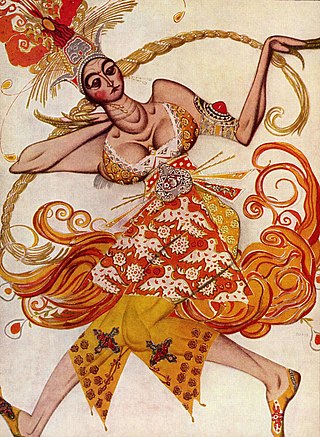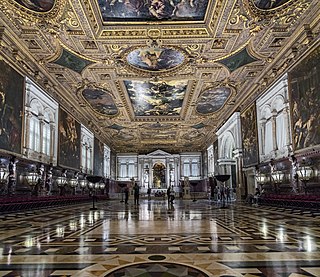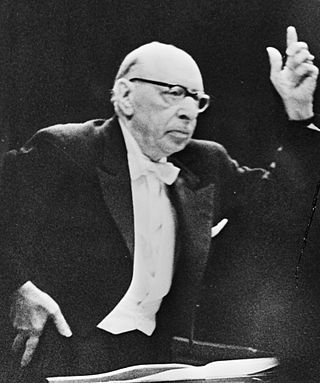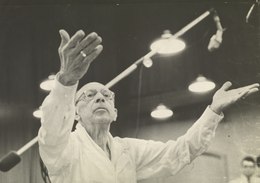
Louis Joseph Andriessen was a Dutch composer, pianist and academic teacher. Considered the most influential Dutch composer of his generation, he was a central proponent of The Hague school of composition. Although his music was initially dominated by neoclassicism and serialism, his style gradually shifted to a synthesis of American minimalism, jazz and the manner of Stravinsky.

Igor Fyodorovich Stravinsky was a Russian composer and conductor with citizenship in France and the United States. He is widely considered one of the most important and influential composers of the 20th century and a pivotal figure in modernist music.

The Rite of Spring is a ballet and orchestral concert work by the Russian composer Igor Stravinsky. It was written for the 1913 Paris season of Sergei Diaghilev's Ballets Russes company; the original choreography was by Vaslav Nijinsky with stage designs and costumes by Nicholas Roerich. When first performed at the Théâtre des Champs-Élysées on 29 May 1913, the avant-garde nature of the music and choreography caused a sensation. Many have called the first-night reaction a "riot" or "near-riot", though this wording did not come about until reviews of later performances in 1924, over a decade later. Although designed as a work for the stage, with specific passages accompanying characters and action, the music achieved equal if not greater recognition as a concert piece and is widely considered to be one of the most influential musical works of the 20th century.

The Firebird is a ballet and orchestral concert work by the Russian composer Igor Stravinsky. It was written for the 1910 Paris season of Sergei Diaghilev's Ballets Russes company; the original choreography was by Michel Fokine, who collaborated with Alexandre Benois and others on a scenario based on the Russian fairy tales of the Firebird and the blessing and curse it possesses for its owner. The Firebird was first performed at the Opéra de Paris on 25 June 1910 and was an immediate success, catapulting Stravinsky to international fame and leading to future Diaghilev-Stravinsky collaborations like Petrushka (1911) and The Rite of Spring (1913).

Renard: histoire burlesque chantée et jouée, or The Fox: burlesque tale sung and played, is a chamber opera-ballet for four male voices and 16 instrumentalists written in 1916 by Igor Stravinsky. Its original Russian text, by the composer, derives from a folk tale as collected by Alexander Afanasyev — but the piece has no name in Russian, being titled generically instead as Байка про лису, петуха, кота, да барана, or Tale of the Fox, the Cock, the Cat and the Ram. The premiere took place in a French translation in Paris on 18 May 1922. Duration: 16–17 minutes.
Elegy for J.F.K. is a piece of vocal music composed by the Russian-born composer Igor Stravinsky in 1964, commemorating the assassination of U.S. President John F. Kennedy.
Requiem Canticles is a 15-minute composition by Igor Stravinsky, for contralto and bass soli, chorus, and orchestra. Stravinsky completed the work in 1966, and it received its first performance that same year.

Threni: id est Lamentationes Jeremiae Prophetae, usually referred to simply as Threni, is a musical setting by Igor Stravinsky of verses from the Book of Lamentations in the Latin of the Vulgate, for solo singers, chorus and orchestra. It is important among Stravinsky's compositions as his first and longest completely dodecaphonic work, but is not often performed. It has been described as "austere" but also as a "culminating point" in his career as an artist, "important both spiritually and stylistically" and "the most ambitious and structurally the most complex" of all his religious compositions, and even "among Stravinsky's greatest works".

The Octet for wind instruments is a chamber music composition by Igor Stravinsky, completed in 1923.
Variations: Aldous Huxley in memoriam is Igor Stravinsky's last major orchestral composition, written in 1963–64.
Fanfare for a New Theatre is a 1964 composition for two trumpets by Russian composer Igor Stravinsky. It was premiered on April 19, 1964, and published by Boosey & Hawkes.

Abraham and Isaac is a sacred ballad for baritone and orchestra composed in 1962–63 by Igor Stravinsky.
"Epitaphium" is a short chamber-music composition by Igor Stravinsky, for flute, clarinet, and harp. The score was composed in 1959 and is inscribed in German, "Für das Grabmal des Prinzen Max Egon zu Fürstenberg". A performance last for less than two minutes.
Scherzo fantastique, op. 3, composed in 1908, is the second purely orchestral work by Igor Stravinsky. Despite the composer's later description of the work as "a piece of 'pure', symphonic music", the work was inspired by Maurice Maeterlinck's 1901 essay "La Vie des Abeilles", as is made clear in a letter of 18 June 1907 from the composer to his teacher Rimsky-Korsakov. Ten years later, Léo Staats adapted it as a ballet for the Opéra Garnier, with the title Les Abeilles, which was objected to by Maeterlinck.

Movements is a 1959 five-movement work for piano and orchestra by Igor Stravinsky lasting about ten minutes. It was written during his serial period and shows his dedication to that idiom as well as the influence of Anton Webern.
The Septet for clarinet, bassoon, horn, piano, violin, viola and cello is a Chamber music composition by Igor Stravinsky. It was composed between July 1952 and February 1953, and the first performance took place at Dumbarton Oaks in Washington, D.C., on 23 January 1954. The score is dedicated to the Dumbarton Oaks Research Library and Collection. It consists of three movements, the first lacking a title, and the last lacking a number in the score. The work is influenced by twelve-tone technique, especially by the Wind Quintet, Op. 26, and the Suite for septet, Op. 29, composed by Arnold Schoenberg.

Ave Maria is a short motet for SATB chorus by Russian composer Igor Stravinsky.

Lied ohne Name, sometimes also entitled Lied ohne Namen and Duet for Two Bassons, is a composition for two bassoons by Igor Stravinsky.

The Greeting Prelude is an orchestral work composed in 1955 by Igor Stravinsky. Its origins can be traced back to an incident that occurred during a rehearsal at the inaugural Aspen Festival in 1950, when Stravinsky was displeased by a surprise rendition of "Happy Birthday to You", a song with which he was unfamiliar. The next year, at the request of Samuel Barber, he harmonized it and composed a two-part canon as a birthday present for Mary Louise Curtis. In February 1955, Charles Munch, music director of the Boston Symphony Orchestra, contacted Stravinsky with a request for a brief orchestral tribute for Pierre Monteux's 80th birthday. After initially expressing uncertainty that he could accept the commission, he composed Greeting Prelude between February 18 and 23.










